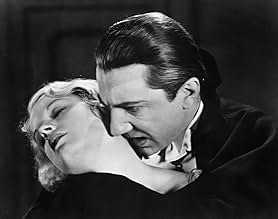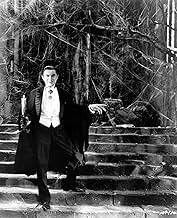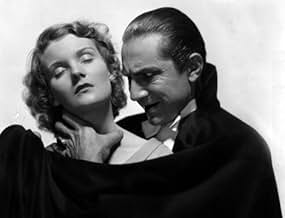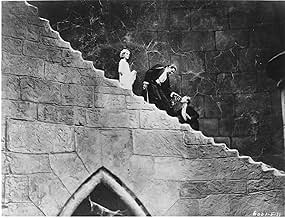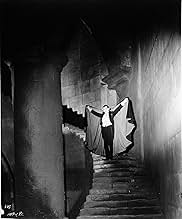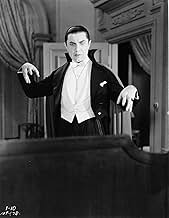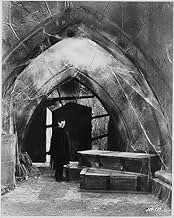Dracula
- 1931
- Tous publics
- 1h 15min
NOTE IMDb
7,3/10
62 k
MA NOTE
Le vampire ancien et comte Dracula arrive en Angleterre et commence à s'en prendre à la jeune et vertueuse Mina.Le vampire ancien et comte Dracula arrive en Angleterre et commence à s'en prendre à la jeune et vertueuse Mina.Le vampire ancien et comte Dracula arrive en Angleterre et commence à s'en prendre à la jeune et vertueuse Mina.
- Réalisation
- Scénario
- Casting principal
- Récompenses
- 5 victoires et 3 nominations au total
Charles K. Gerrard
- Martin
- (as Charles Gerrard)
Anna Bakacs
- Innkeeper's Daughter
- (non crédité)
Bunny Beatty
- Flower Girl
- (non crédité)
Nicholas Bela
- Coach Passenger
- (non crédité)
Daisy Belmore
- Coach Passenger
- (non crédité)
William A. Boardway
- Concertgoer Outside Theatre
- (non crédité)
Barbara Bozoky
- Innkeeper's Wife
- (non crédité)
Tod Browning
- Harbormaster
- (voix)
- (non crédité)
Moon Carroll
- Maid
- (non crédité)
Geraldine Dvorak
- Dracula's Wife
- (non crédité)
Avis à la une
Dracula is a figure that is known by virtually all and can be credited in large part to this 1931 classic. Bela Lugosi who plays Count Dracula is horrifyingly creepy and finding a better Dracula would be nearly impossible. From the first encounter between Renfield and Dracula to the closing scene, the audience is on the edge of their seats and don't know what to expect, which is an essential part of most horror movies. I was a big fan of this film not only because it is an American classic but because it is a true horror film. In my opinion, too often in horror films today, the story itself isn't scary at all. The experience of going to the movie theatre with a huge screen and incredibly loud speakers help scare audiences by having things pop out when you are least expecting it. I believe that anyone can make a movie like that and is completely insignificant. The story behind Dracula is truly creepy and horrifying. A great story like this makes this one of the most significant horror films in history.
... and that explains all of the differences, such as Renfield being the person to visit Dracula in Transylvania to seal a real estate deal rather than Jonathan Harker.
I imagine this was quite the spectacle in 1931. Visually it still is - sweeping staircases, ruined old castles covered in dust, moonlight illuminating giant spiderwebs, coffins with limbs hanging out of them, rats scurrying about. And Bela Lugosi, who starred in the Broadway play, was dying to play the lead. But director Tod Browning was set on Lon Chaney, a frequent collaborator, playing both Dracula and Van Helsiing.
It's not true that everybody is replaceable, but it IS true that eventually an irreplaceable person will no longer be around and a perhaps less than ideal work-around must be found. This was the situation with Chaney - a unique actor who could convince you he was anybody. He died before Dracula was filmed. Lugosi successfully lobbied for the part, although he did so at a cut rate. Today his old world hypnotic presence is synonymous with the role.
But I have to admit I have an unpopular opinion. To me Dracula seems very slow and very much "early talkie" in personality when compared to the film Frankenstein of just a year later. Also, like many early talking films that were not musicals, there is no score.
And I have to wonder about director Tod Browning. Although this was Browning's biggest hit, his other enduring works all starred Lon Chaney. He only directed a few more films and disappeared from the industry for a quarter of a century until his death. He had a disappearing act worthy of Universal Horror.
Things to watch for - Armadillos in Transylvania? Probably far too cold for them there. David Manners and Helen Chandler as young lovers Jonathan Harker and Mina - They have all of the chemistry of two cardboard boxes. Why did they keep pairing these two in films? Dwight Frye as Renfield - did Frye EVER get to play a normal person? And why would he want to be sent away? He gets to wander in and out of the lush living quarters of the superintendent f the mental facility. He wouldn't get that freedom anywhere else. And last but not least, Carla Laemmle, unrecognizable as a tourist, reading from a Transylvania tour guide.
I imagine this was quite the spectacle in 1931. Visually it still is - sweeping staircases, ruined old castles covered in dust, moonlight illuminating giant spiderwebs, coffins with limbs hanging out of them, rats scurrying about. And Bela Lugosi, who starred in the Broadway play, was dying to play the lead. But director Tod Browning was set on Lon Chaney, a frequent collaborator, playing both Dracula and Van Helsiing.
It's not true that everybody is replaceable, but it IS true that eventually an irreplaceable person will no longer be around and a perhaps less than ideal work-around must be found. This was the situation with Chaney - a unique actor who could convince you he was anybody. He died before Dracula was filmed. Lugosi successfully lobbied for the part, although he did so at a cut rate. Today his old world hypnotic presence is synonymous with the role.
But I have to admit I have an unpopular opinion. To me Dracula seems very slow and very much "early talkie" in personality when compared to the film Frankenstein of just a year later. Also, like many early talking films that were not musicals, there is no score.
And I have to wonder about director Tod Browning. Although this was Browning's biggest hit, his other enduring works all starred Lon Chaney. He only directed a few more films and disappeared from the industry for a quarter of a century until his death. He had a disappearing act worthy of Universal Horror.
Things to watch for - Armadillos in Transylvania? Probably far too cold for them there. David Manners and Helen Chandler as young lovers Jonathan Harker and Mina - They have all of the chemistry of two cardboard boxes. Why did they keep pairing these two in films? Dwight Frye as Renfield - did Frye EVER get to play a normal person? And why would he want to be sent away? He gets to wander in and out of the lush living quarters of the superintendent f the mental facility. He wouldn't get that freedom anywhere else. And last but not least, Carla Laemmle, unrecognizable as a tourist, reading from a Transylvania tour guide.
This is an immensely enjoyable version of 'Dracula'. It is not perfect, as I will explain in a minute, but the acting is excellent throughout. Lugosi, who of course plays the eponymous count, gives a performance that is equally cultured and creepy (as far as I know he pioneered this interpretation), and I also liked Helen Chandler as Mina, David Manners as Harker and Dwight Frye as Renfield. The story has been changed from Bram Stoker's novel, in part quite substantially so, but the changes work well. My one quibble in this context is that the ending of the film is abrupt and unconvincing. In want to avoid spoilers, so I won't tell, but at 1 hour 15 minutes I would have thought that a few minutes more to wrap up things and provide an explanation for one person's miraculous recovery/survival should have been possible. The photography is excellent, especially the scenes in Transylvania. I was initially startled to find an opossum and an armadillo in the Carpathians, but after all, vampire bats are from South America, too, so why not? Speaking of bats: director Tod Browning judiciously decided not to use special effects (for example to show how Dracula transforms into diverse creepy animals), but he did include bats flapping about, and they don't work. They really don't. They look like Tutulla the bat in 'Kleiner König Kalle Wirsch' by the 'Augsburger Puppenkiste' theatre that was on the TV when I was a kid (check it here: https://www.imdb.com/title/tt0184133/?ref_=nv_sr_srsg_0; https://www.imdb.com/title/tt0184133/mediaviewer/rm2171260161/). Bad idea, but still: Great acting, the plot works mostly well, and very good photography with a few limitations. In sum: a very good film.
The 1931 `Dracula' casts an imposing shadow over the horror genre. It is, after all, the movie that launched the classic Universal horror cycle of the 1930s and 1940s. It is also a tremendous influence on the look and atmosphere of horror movies in general (and vampire movies in particular). It gave Dracula a look and a voice, and created a legend.
Okay, so we know it was influential. But how does it work as a movie? Well the first time I watched it, I was underwhelmed. The pace is slow. While Bela Lugosi's Dracula is menacing, the rest of the cast is colorless to the point of transparency. There are some good gliding camera shots here and there (thank you, Karl Freund!), but the majority of the film is locked into stationary medium and long shots. The film is tightly bound to its theatrical origins director Browning has his characters look at things out of frame and describe them rather than just showing us, which would be much more effective.
Fortunately, `Dracula' improves with repeated viewings. The glacial pace and lack of sound in many places gives the movie a nightmarish sense of menace. In fact, `Dracula' is somewhere between a nightmare and a piece of classical music everything proceeds at its own pace, gliding through the motions, gradually building suspense and momentum until the piece reaches climax. The end result is a flawed but haunting, hypnotic masterpiece, and one of the greatest vampire films ever made.
Okay, so we know it was influential. But how does it work as a movie? Well the first time I watched it, I was underwhelmed. The pace is slow. While Bela Lugosi's Dracula is menacing, the rest of the cast is colorless to the point of transparency. There are some good gliding camera shots here and there (thank you, Karl Freund!), but the majority of the film is locked into stationary medium and long shots. The film is tightly bound to its theatrical origins director Browning has his characters look at things out of frame and describe them rather than just showing us, which would be much more effective.
Fortunately, `Dracula' improves with repeated viewings. The glacial pace and lack of sound in many places gives the movie a nightmarish sense of menace. In fact, `Dracula' is somewhere between a nightmare and a piece of classical music everything proceeds at its own pace, gliding through the motions, gradually building suspense and momentum until the piece reaches climax. The end result is a flawed but haunting, hypnotic masterpiece, and one of the greatest vampire films ever made.
"I bid you welcome," "I never drink wine," "Children of the night...what music they make," and of course "I am Dracula" are memorable lines that resonate throughout horror films, literature, art, etc... throughout the 20th century because of a landmark film made in 1931 starring Bela Lugosi and directed by Tom Browning. This film was the birth of the horror film as we know it. Its importance can not be underestimated. Dracula is a wonderful film for so many reasons, but first let's look at its many faults.
The film is by today standards very antiquated. It has almost no soundtrack, stage acting for the most part, limited special effects, and a slow pacing. It has long parts of little action and lots of chat. It shows little while leaving much to one's imagination(a plus for those like myself that are good at envisioning what is not shown). With all this not going for it, why is Dracula such a classic? Why is it considered to be such a great film and a great horror film?
The answer is that even with all these flaws (and bear in mind some of these flaws are not flaws for all) the film offers a rich story in an eerie, atmospheric way. Bela Lugosi was Dracula. He was the model for oh so many vampires to come. His gesturing, his deliberation in speech, his facial movements all created a vampire never to be forgotten. Despite Lugosi, however, is the real genius of the film....Tod Browning. Browning created a movie and a setting hitherto imagined and conjured on a screen. Browning was the man behind the camera that created the cob-webbed stairs of the Dracula castle and the squalid emptiness of the crypt. He created the ghoulish female vampires thirsting for blood. Dracula is not just a film to see, it is film history and should be viewed with that in mind and not put under a microscope of today's languishing tastes.
The film is by today standards very antiquated. It has almost no soundtrack, stage acting for the most part, limited special effects, and a slow pacing. It has long parts of little action and lots of chat. It shows little while leaving much to one's imagination(a plus for those like myself that are good at envisioning what is not shown). With all this not going for it, why is Dracula such a classic? Why is it considered to be such a great film and a great horror film?
The answer is that even with all these flaws (and bear in mind some of these flaws are not flaws for all) the film offers a rich story in an eerie, atmospheric way. Bela Lugosi was Dracula. He was the model for oh so many vampires to come. His gesturing, his deliberation in speech, his facial movements all created a vampire never to be forgotten. Despite Lugosi, however, is the real genius of the film....Tod Browning. Browning created a movie and a setting hitherto imagined and conjured on a screen. Browning was the man behind the camera that created the cob-webbed stairs of the Dracula castle and the squalid emptiness of the crypt. He created the ghoulish female vampires thirsting for blood. Dracula is not just a film to see, it is film history and should be viewed with that in mind and not put under a microscope of today's languishing tastes.
Le saviez-vous
- AnecdotesGenerally regarded as the film that kickstarted the horror genre in Hollywood.
- GaffesIn the scene where Van Helsing is attempting to catch Dracula's lack of reflection in a mirror, there are visible chalk marks on the floor showing Bela Lugosi where to stand for the shot.
- Citations
Count Dracula: This is very old wine. I hope you will like it.
Renfield: Aren't you drinking?
Count Dracula: I never drink... wine.
- Crédits fousThe original title card has producer Carl Laemmle, Jr. identified as Presient (sic).
- Versions alternativesA version of the film played on the 10/24/15 airing of Svengoolie (1995) featured a soundtrack taken from the French language audio track on the Dracula Blu-ray.
- ConnexionsAlternate-language version of Drácula (1931)
- Bandes originalesSwan Lake, Op.20
(1877) (uncredited)
Music by Pyotr Ilyich Tchaikovsky
Excerpt Played during the opening credits
Meilleurs choix
Connectez-vous pour évaluer et suivre la liste de favoris afin de recevoir des recommandations personnalisées
- How long is Dracula?Alimenté par Alexa
- What is 'Dracula' about?
- Is 'Dracula' based on a book?
- How does the movie end?
Détails
Box-office
- Budget
- 355 000 $US (estimé)
- Montant brut mondial
- 87 019 $US
- Durée1 heure 15 minutes
- Rapport de forme
- 1.20 : 1(original release)
Contribuer à cette page
Suggérer une modification ou ajouter du contenu manquant



